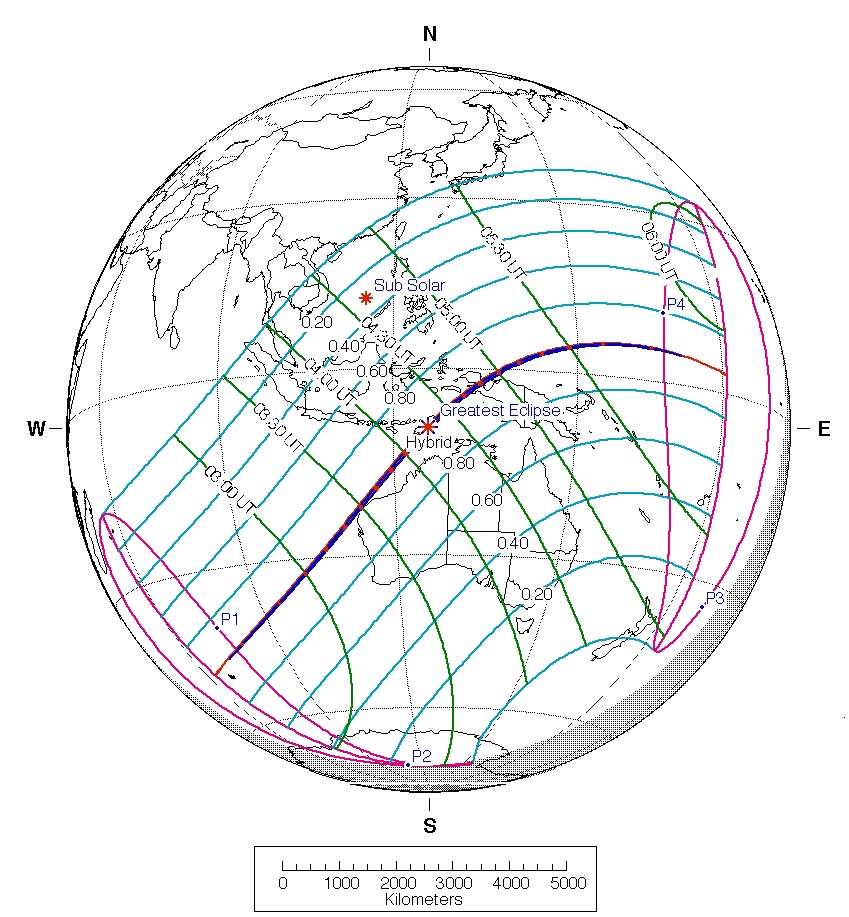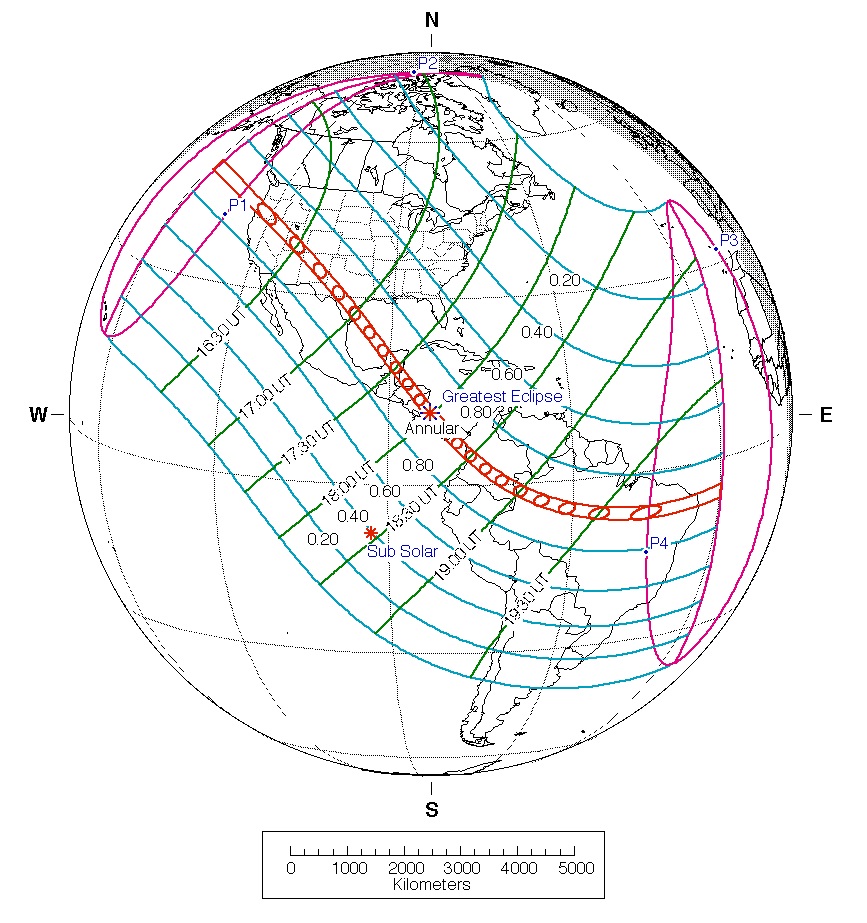A Hybrid Solar Eclipse On April 20th, 2023
A Hybrid Solar Eclipse is a rare type of solar eclipse that starts as an annular eclipse, turns into a total eclipse, and then ends as an annular eclipse. It is so named because it switches between two different types of eclipse, annular and total. On April 20th, 2023, a Hybrid Solar Eclipse will take place, with partial visibility in southeast Asia, East Indies, Australia, Philippines, and New Zealand and hybrid visibility in Australia, Timor-Leste, Indonesia (West Papua and Papua). The moment of greatest eclipse will occur at 04:17:56 TD (04:16:45 UT1) which is 4.1 days after the Moon reaches its perigee. During the eclipse, the Sun will be in the constellation Aries. This Hybrid Solar Eclipse is one of the rare kind and starts as an annular eclipse and ends as an annular eclipse with a total phase in between. It will be followed two weeks later by a Penumbral Lunar Eclipse on May 5th, 2023.
A Penumbral Lunar Eclipse On May 5th, 2023
A Penumbral Lunar Eclipse occurs when the Earth passes between the Sun and the Moon, casting only the outer part of its shadow, called the penumbra, on the Moon. On May 5th, 2023, Africa, Asia, and Australia will be able to see a Penumbral Lunar Eclipse. The peak of the eclipse will happen at 5:24 PM TD (5:22 PM UT1), five and a half days before the Moon is at its closest point to Earth. This particular eclipse is a deep penumbral eclipse, with a magnitude of 0.9655 and a duration of 258.3 minutes and a Gamma value of -1.0350. It's worth noting that two weeks earlier before this penumbral lunar eclipse, on April 20th, there will be a Hybrid Solar Eclipse.

Annular Solar Eclipse On October 14th 2023
An Annular Solar Eclipse is a type of solar eclipse in which the Moon appears slightly smaller than the Sun, leaving a "ring of fire" visible around the edges of the Moon. On October 14th, 2023, an Annular Solar Eclipse will take place, with partial visibility in North America, Central America, and South America and annular visibility in the West United States, Central America, Colombia, and Brazil. The moment of greatest eclipse will occur at 18:00:41 TD (17:59:29 UT1) which is 4.6 days after the Moon reaches its apogee. During the eclipse, the Sun will be in the constellation Virgo. This Annular Solar Eclipse will be followed two weeks later by a Partial Lunar Eclipse on October 28th, 2023.
partial lunar eclipse On October 28 2023
On October 28, 2023, a partial lunar eclipse will be visible in the eastern Americas, Europe, Africa, Asia, and Australia. The moment of maximum eclipse will occur at 8:15 PM TD (8:14 PM UT1), two and a half days after the Moon reaches its closest point to Earth. During the eclipse, the Moon will be located in the constellation Aries. It's worth noting that two weeks earlier before this partial lunar eclipse, on October 14, there will be an annular solar eclipse.

In 2023, here are the astronomical events not to be missed each month:
January :
On January 3, the conjunction of the gibbous Moon with Mars will provide a beautiful occultation of Mars, visible exclusively in the southern hemisphere.
On the night of January 3 to 4, the maximum activity of the Quadrantids, a large meteor shower, will unfortunately be hindered by the gibbous Moon.
On January 4 at 5:17 p.m., the Earth will reach perihelion, that is to say that it will be closest to the Sun (at 147 million kilometers).
On January 12, comet C/2022 E3 (ZTF) will reach its shortest distance from the Sun and will become visible to the naked eye at the end of the month.
At dusk on January 23, Venus and Saturn will form a bright duo under the aegis of the crescent Moon, observable between southwest and west.
On January 25, the Moon will shine between Jupiter and Neptune (Neptune being not observable with the naked eye)
On January 30, a new occultation of Mars by the Moon will be visible from Central America and the Caribbean.
February :
On February 1, Comet C/2022 E3 (ZTF) will reach its closest point to Earth and is expected to be very bright. Comet C/2022 E3 (ZTF) is a comet discovered in 2022 by the Zwicky Transient Facility (ZTF) collaboration, a transient detection project based at the California Institute of Technology (Caltech) and the University of Washington. It is considered an interesting comet for observations because it becomes visible to the naked eye at certain times in its orbit, and perhaps of quite high luminosity. However, it is important to note that predictions for comets can vary widely due to uncertainties in trajectory and brightness evolution calculations. It is therefore important to follow the updates for the most accurate observations.
March :
On March 1 at dusk, Venus will visit Jupiter above the western horizon, forming a beautiful observable pair with binoculars or a telescope.
On March 20 at 9:24 p.m. UT, the vernal equinox will occur in the northern hemisphere and the autumnal equinox in the southern hemisphere.
April :
On April 22, the waning crescent Moon will form golden horns above Venus, observable with the naked eye, binoculars or telescope.
On April 22 and 23, the maximum activity of the Lyrid meteor shower
June:
Between June 1 and 3: At the start of the night, Mars will pass by the open cluster Messier 44 (M44), also known as the Hive or Crèche. This encounter will be magnificent to observe with an instrument, although the two objects are separated by more than 600 light years.
June 13: at the beginning of the night, towards the northwest, Venus will pass near the Hive.
June 21 at 2:57 p.m. UT: summer solstice in the northern hemisphere and winter solstice in the southern hemisphere.
June 22: Venus and Mars will meet in the sky above the west, accompanied by the Moon.
July:
July 20, at dusk: a beautiful trio to be seen over the west, consisting of Venus, Mars and the Moon.
August:
August 12 and 13: the Perseids, one of the most beautiful meteor showers of the year, will reach their maximum activity. The waning Moon will rise late, providing favorable conditions for observation.
September:
September 23 at 6:50 a.m. UT: autumnal equinox in the northern hemisphere and spring equinox in the southern hemisphere.
October:
October 20 and 21: The Oriondes, another meteor shower, will peak with about 20 visible meteors per hour on average.
November:
November 17 and 18: the Leonids will reach their maximum activity, with about fifteen meteors visible per hour. The waxing Moon will set quite early, providing favorable conditions for viewing.
December:
December 13-14: The Geminid meteor shower will peak in activity, averaging around 120 meteors per hour. The Moon will be in a waxing phase, but will set quite early, providing favorable conditions for observation.
On December 22, 2023 at 3:27 UT, the winter solstice will occur in the northern hemisphere, while the summer solstice will occur in the southern hemisphere. This marks the end of autumn and the beginning of winter in the northern hemisphere, with a total duration of 89 days, 20 hours, 37 minutes, and 22.30 seconds.









